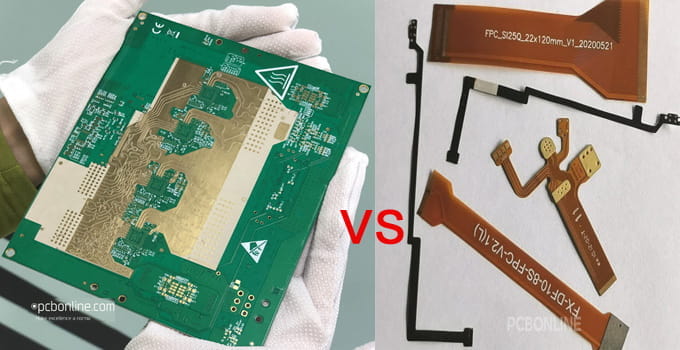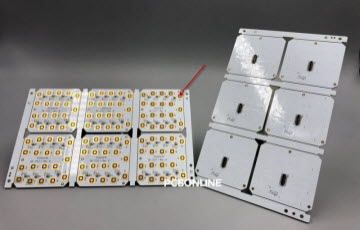Rigid PCBs are the most common printed circuit boards using the solid substrate material, which can be FR4 (epoxy fiber-glass in the flame retardant Level 4), aluminum, copper, ceramic (mainly aluminum nitride and aluminum oxide), and Teflon (or PTFE). Rigid PCBs can be single-component-mounting-sided, dual-component-mounting-sided, single-layer, double-layer, and multilayer. Choosing the type of rigid PCBs depends on the project and application you are working on.
What are the features of different rigid PCBs? When do you use rigid PCBs? Check the content below.
Part 1: Rigid PCBs vs Flexible PCBs

PCB is the basis of electrical and electronic appliances, and there are rigid PCBs and flexible PCBs. (Note: rigid-flex PCBs belong to flexible PCBs.)
As the names suggest, rigid PCBs are solid and have strong mechanical strength, and flexible PCBs are bendable and can fit in compact spaces by twisting and bending.
PCBs consist of the PCB substrate, copper layers, prepreg layers, and solder masks. Rigid PCBs' substrate materials include FR4, aluminum, copper, ceramic, and PTFE. Flexible PCB substrate materials are polyimide and polyester. However, this is not absolute, as there are polyimide rigid PCBs and flexible aluminum PCBs.
Compared with flex PCBs, rigid PCBs have better thermal conductivity, mechanical strength, and more design space. On the other hand, rigid PCBs are larger and heavier than flex PCBs.
In regards to PCB layers and copper thickness, rigid PCBs can be up to 64 layers, and PCB copper thickness can be up to 14oz. While flexible PCB have PCB layers of up to 10 and copper thickness of up to 3oz.
In PCB fabrication prices, FR4 PCBs and aluminum PCBs are far cheaper than flexible PCBs. Ceramic PCBs, Teflon PCBs, and copper-based PCBs are costly to fabricate, and you'll know the PCB price by getting a quote from the PCB manufacturer.
In applications, flexible PCBs are used in compact spaces like gaps, edges, and bending points to connect the circuits and transfer signals. Rigid PCBs are widely used, such as computer motherboards, industrial controller boards, sensors, power devices, ignition coils, LED lights, keypads, laser heads, etc.
If you need rigid or flexible PCBs, you can work with the PCB source factory manufacturer PCBONLINE.
Part 2: Rigid PCB Types, Features, and Applications
Based on the different substrate materials, rigid PCBs are classified as FR4 PCBs, aluminum PCBs, copper-base PCBs, ceramic PCBs, and Teflon PCBs.
FR4 PCB
FR4 PCBs are the most common rigid PCBs and offer great space for design possibilities. They can be single-sided or double-sided, the PCB layers can be from 1 to 64, and the copper thickness of the circuit layers can be from 1/3oz to 14oz. The PCB size ranges from 5mm × 5mm to 1500mm × 1200mm, and the circuits can be high-density.

Besides, epoxy glass fiber has good rigidity, mechanical strength, and resistance to moist, chemical, and high temperatures. The Tg (glass transition temperature) of FR4 PCBs is determined by the copper-clad laminate type, and it varies from 120°C to 220°C. (Note: the working temperatures of an FR4 PCB are 40°C lower than the Tg.)
However, the best advantage of FR4 PCBs is cost-effectiveness. A multilayer FR4 PCB costs only several dollars. While flexible PCBs are about ten times more expensive than FR4 PCBs. For a quick look at how much your FR4 PCB is, you can get an instant free quote from PCBONLINE's online quote system.
Aluminum PCB
aluminum PCB is the most used IMS board. An aluminum PCB has an aluminum substrate, copper layers, and prepreg layers made of a special polymer filled with ceramics. Because of the prepreg layers, the thermal conductivity of aluminum PCB is about 1W/mK to 9W/mK. (Note: FR4 PCBs have a thermal conductivity of 0.25W/mK to 2W/mK. So still, aluminum PCBs are times better in thermal dissipation than FR4 PCBs.)

The more prepreg layer, the worse thermal conductivity. Due to the limits of prepreg, aluminum PCBs provide a smaller design space for engineers - only 1 to 4 layers are available, and the circuit copper thickness is 1oz to 6oz. An aluminum PCB can be both single and double component-mounting sided.
Besides better thermal conductivity than FR4 PCBs, aluminum PCBs are also cost-effective. From the PCB manufacturer PCBONLINE who achieves automatic fabrication, you'll only spend $39 for a square meter of aluminum PCBs!
What applications do you use aluminum PCBs for? Most LED lights for home and public uses and automotive use aluminum PCBs.
Copper-base PCBs
For PCBs, copper can be used not only as the circuit layer but also as the substrate material. Having the same prepreg layers, copper-based PCBs have better thermal conductivity than aluminum PCBs.

Regular copper-based PCBs have 1 to 4 layers. But the thermoelectric separation technology enables copper-base PCBs to have up to 8 PCB layers, and the thermal conductivity reaches 398W/mK, which is the same as that of copper!
Besides, copper-based PCBs can be HDI and hybrid-laminated with other substrate materials, such as FR4 and ceramic.
Copper-based PCBs are used for applications that require great thermal dissipation, such as high-power automotive lights, charging stations for electronic vehicles, and chip-on-board (COB) LED lights.
Ceramic PCB
Ceramic PCBs include aluminum nitride (AlN) PCBs, aluminum oxide (alumina) PCBs, silicon nitride (Si₃N₄) PCBs, silicon carbide (SiC) PCBs, sapphire PCBs, and zirconia (ZrO) PCBs.

Ceramic PCBs have the best thermal conductivity. The thermal conductivity of AlN PCBs is 180W/mK, and that of alumina PCBs is 20W/mK.
Apart from excellent thermal conductivity, ceramic PCBs have a small and stable dielectric constant (DK), dielectric loss (Df), and thermal expansion. The AlN PCBs' thermal expansion is close to that of semiconductors. Besides, ceramic PCBs have high rigidity and good resistance to chemicals, vibration, high voltages, and high and low temperatures. And the water absorption rate of ceramic PCBs is 0.
Many think the most obvious drawback of ceramic PCBs is brittleness. However, Si₃N₄PCBs are not fragile and can be used as the base and enclosure of IGBT.
Ceramic PCBs are used for applications that require good thermal dissipation, and excellent dielectric performances, and can work in great temperature changes. Power devices such as IGBT, IPM, rectifier bridges, silicon-controlled rectifiers, and triodes use ceramic PCBs. Ceramic PCBs are also used for automotive electronics in all kinds of sensors, ignition coils, radars, electronic shifts, and air condition systems. Laser heads, red wine shelves, hair removal devices for beauty, heat-to-electricity generators, optical communications, and high-power LED lights also use ceramic PCBs.
Teflon PCB
Teflon is the most famous brand name for polytetrafluoroethylene (PTFE). Teflon PCBs, or PTFE PCBs, are high-frequency PCBs that transmit and receive radio frequency (RF) waves.

PTFE is a relatively soft material that is sensitive to temperature changes. The thermal expansion and contraction affect the dielectric performances of Teflon PCBs. The high-frequency PCB manufacturer must be able to keep the laminate's expansion coefficient to be as small as possible.
Besides of small and stable expansion coefficient, reliable PTFE PCBs should have stable signals. And the PTFE PCB manufacturer should have ready-to-use PTFE copper-clad laminates in stock and can ensure fast delivery.
PCBONLINE is such a reliable PTFE PCB one-stop manufacturer. It controls the laminate expansion coefficient, trace tolerance, and laminate size tolerance to be as small as possible. The Teflon laminates it has in stock include Rogers, Taizhou Wangling, Taconic, and Nelco. And the laminates in stock are stored within 45 days to ensure the best PCB quality.
In regards to applications, high-frequency PCBs are used for antennas, radars, GPS, object positioning, and anti-collision for wireless communications, automotive, defense/military, aerospace, and aviation.
Part 3: When do You Use Rigid PCBs?
Rigid PCBs are used when there's no need for flexibility and the space and weight allow. By the use of rigid PCBs, you can:

- Have better control over the fabrication budgets of your project,
- Achieve ultra-fine and high-density circuits,
- Have a large design space for your PCBs,
- Create products with good thermal dissipation and mechanical strength that are uneasy to deform.
Part 4: One-Stop Rigid PCB Source Manufacturer for Your Project
A PCB source manufacturer means the manufacturer is the direct manufacturer with the PCB factory and finishes all the fabrication processes. Working with a source manufacturer can save fabrication costs to be the best and have good control over the whole project fabrication process.
PCBONLINE has two advanced PCB manufacturing bases in Jiangsu and Jiangxi and one PCB assembly factory for EMS production in Shenzhen of Guangdong. PCBONLINE's first PCB factory of PCBONLINE was founded in 1999, and its PCBA factory has more than 10 years of experience in EMS manufacturing.

By working with PCBONLINE for rigid PCB fabrication and assembly, you can enjoy these benefits:
- PCBONLINE fabricates and assembles all kinds of rigid PCBs from prototype to bulk production.
- One-on-one engineering support throughout your project and design for manufacturing (DFM).
- Our CAM engineer with more than 20 years of experience can assist you in gaining the optimal PCB design before production, which saves the fabrication costs to the best.
- Strong PCB/PCBA manufacturing capabilities from 1 to 64 layers meeting every fabrication requirement of your project.
- Fast PCB and PCBA delivery. For an expedited advanced PCBA sample order, we spend only 3 working days from PCB fabrication to PCB assembly, including component sourcing.
From PCBONLINE, you can enjoy one-stop EMS manufacturing, even including the product enclosure design and assembly and manual design. If you need rigid PCBs, flexible PCBs, and PCBA, feel free to send your inquiry to the source manufacturer PCBONLINE by email at info@pcbonline.com.
Conclusion
Rigid PCBs are solid circuit boards with an FR4, aluminum, copper, ceramic, or Teflon substrate. You can use rigid PCBs in any applications that don't require flexibility and where space allows. If you need rigid PCB fabrication and assembly, work with a source factory manufacturer, and the EMS manufacturer PCBONLINE is a reliable rigid PCB supplier you deserve to consider.
© This article is an original work of the PCBONLINE team. Please indicate the author PCBONLINE if you reprint. If the article is reproduced without permission or indicating the author's source, PCBONLINE reserves the right to investigate the infringement.




